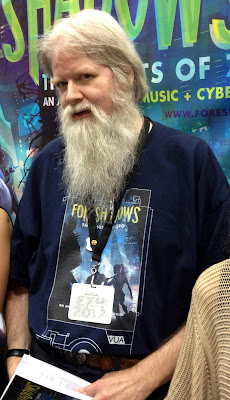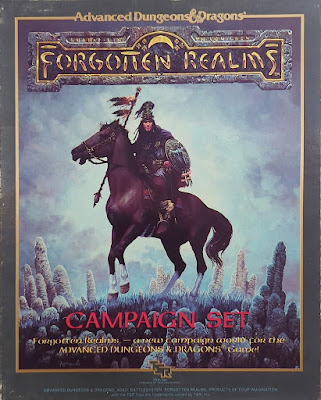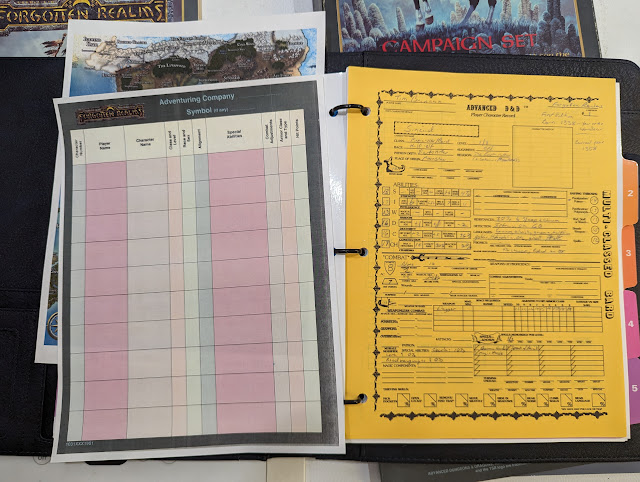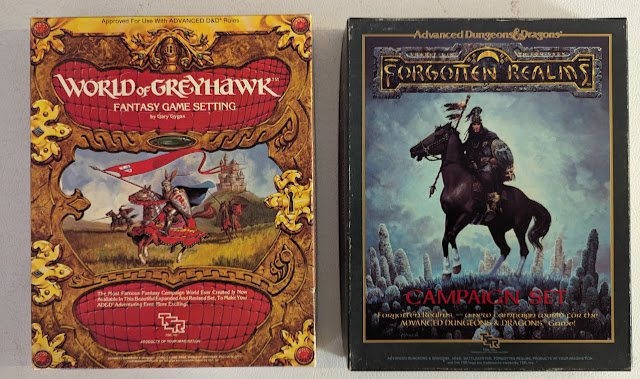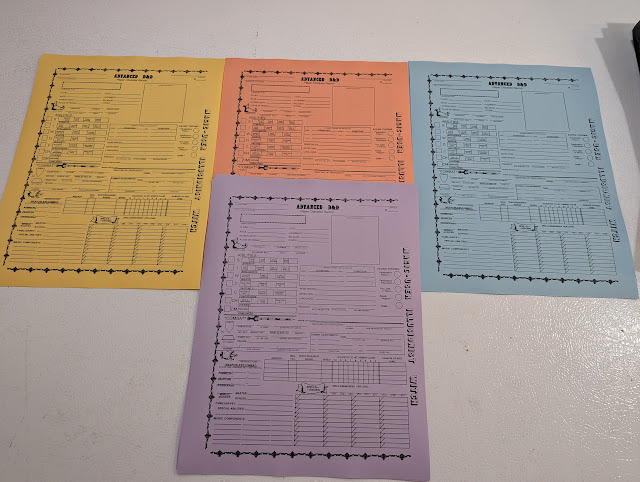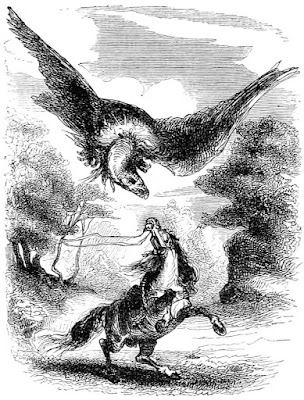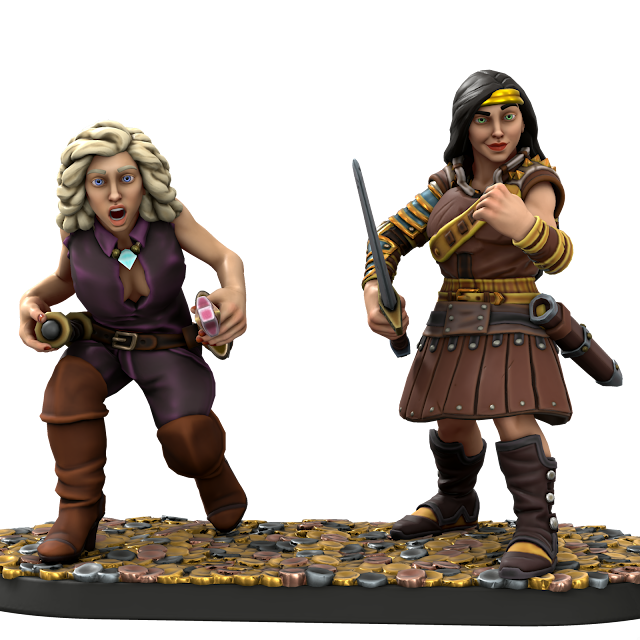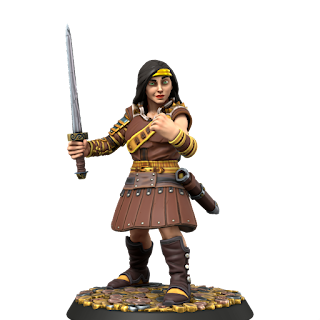1974 is an important year for the gaming hobby. It is the year that Dungeons & Dragons was introduced, the original RPG from which all other RPGs would ultimately be derived and the original RPG from which so many computer games would draw for their inspiration. It is fitting that the current owner of the game, Wizards of the Coast, released the new version, Dungeons & Dragons, Fifth Edition, in the year of the game’s fortieth anniversary. To celebrate this, Reviews from R’lyeh will be running a series of reviews from the hobby’s anniversary years, thus there will be reviews from 1974, from 1984, from 1994, and from 2004—the thirtieth, twentieth, and tenth anniversaries of the titles. These will be retrospectives, in each case an opportunity to re-appraise interesting titles and true classics decades on from the year of their original release.
—oOo—

Five hundred years ago, Rhand was a rich, verdant colony
with vast forests that supported agriculture and attracted tourism.
Technologically advanced, easy travel was facilitated by four satellites which
operated a world-spanning teleport network. Then the Spectrals came. The
faceless, jet black invaders from deep space launched attacks that shattered
the climate, smashed the teleport network, and unleashed bioagents which drove
many of humanity on the planet into barbarism. Five centuries later, Rhand’s
climate is dominated by advancing ice and devastating storms and tornadoes. The
only habitable part of the planet is the equator, populated by a thousand kingdoms
and city states, competing for resources as the war against the Spectrals and
other monsters continues as their societies face further collapse. The only
hope lies in Orca, the last remnant of the government from before the Spectral
attack, dedicated to recovering and protecting what knowledge it can,
conducting operations against the Spectrals, and preventing the total collapse
of society into barbarism and anarchy. Orca fields a range of military and
auxiliary units, the elite of which are named after mythical beasts like the
Dragons and the Targa. Where Targa units specialise in hand-to-hand combat and
heavy assault missions, Dragon units specialise in commando missions and
strategic planning. In addition to its dedicated forces, Orca has one other
advantage—it can anyone anywhere on Rhand. It has access to Morningstar, the
surviving satellite that had been part of the teleportation network. The magic
of the Morningstar is accessed via an Encoder. Activate this and anyone also
wearing a Thrall, a chain worn on the wrist, will be teleported to the desired
destination. However, being the only surviving satellite remaining in the
network means that Morningstar does not cover all of the planet all of the
time. Depending upon Morningstar’s orbital position and the intended
destination, an Orca team can be out of contact with the Morningstar network
for as short as a few hours and as long as two weeks!
This is the set-up for
Rhand: Morningstar Missions. Published in 1984, it was
the first roleplaying game to be designed and released by Leading Edge Games,
which would later be known for the
Phoenix Command combat system and the
Aliens
Adventure Game as well as a number of other licensed roleplaying games. Indeed,
the mechanics for
Rhand: Morningstar Missions were a precursor for
Phoenix
Command, just as its setting would be revisited in
Living Steel. Set not long
after the attack by the Spectrals, this was a prequel to
Rhand: Morningstar Missions, and it would not be until the release of
Rhand 2349, a supplement for
Living Steel, that the world itself would get more detailed attention. At its
heart,
Rhand: Morningstar Missions is a post-apocalyptic setting with magic and
medieval-style combat on a post-technological world. It is a roleplaying game
of special forces-style military missions in which the Player Characters—as
members of Orca—have access to a device which can get them anywhere,
a la
Fringeworthy from Tri Tac Games,
Wraith Recon from Mongoose Publishing, and of
course,
Star Gate: SG1.
A Player Character in
Rhand: Morningstar Missions is defined by his
characteristics, skills, equipment, and various derived factors. The primary
characteristics are Strength, Intelligence, Will, Health, and Agility,
typically ranging in value between three and eighteen, although they can go
higher. The secondary characteristics are Charisma, Motivation, Size, and
Telepathic Sensitivity. The primary characteristics are purchased from a
randomly determined pool of points and the secondary characteristics are all
rolled randomly individually. This requires referencing a number of tables at
the back of the book. Base skill levels are determined randomly. Skills are
rated between one and twenty, with eight being a Professional level and fifteen
World Class. They are categorised into Class 1 General Skills that all
characters possess, and then Class 2 General Skills and Class 3 General Skills,
plus Specialist Skills. The Magic, Medicine, and Science skills fall into the
latter category, as does Special Fighting Forms, themed around the four
elements, which greatly enhance a Player Character’s Combat and Martial Arts
skills. A Player Character only begins play with levels in Class 1 General
Skills, but can dedicate training time between missions to improve already
known skills and learn new ones. This is limited by his rank in the Orca
organisation and only by increasing his rank can he gain the opportunity to
learn or improve Specialist Skills. This also takes him out of play as it
requires dedicated learning time. Training grants a player Training Rolls. Each
one is made against his character’s Learning Roll and if successful, grants him
a Learning Point which can be assigned to a specific skill. When the number of
Learning Points in a skill exceeds the threshold, its Skill Level increases.
So, to become a Professional in a skill, Skill Level 7, a Player Character
needs to accumulate eighty-eight Learning Points, and to be considered World
Class or Skill Level 15, he needs six-hundred-and-seventy-four-Learning-Points!
A beginning Player Character only has the Skill Levels in the Class 1 General
Skills at start of play. Effectively, he is a recruit, waiting to go on his
first mission.
Name: Robert
CHARACTERISTICS
Strength 13
Intelligence 13
Will 10
Health 12
Agility 13
Charisma 15
Motivation 17
Size 11
Telepathic Sensitivity 14
Combat Value: 15
Combat Speed: 1+
Knockout Value: 15
Learning Roll: 84
Magic Learning Roll: 14
Skill Factor: 16
Base Action Time: .8
Damage Bonus: 1.0
SKILLS
Balance and Footwork – LP 0 Level 3
Bard – LP 0 Level 4
Combat – LP 0 Level 3
Diplomacy – LP 0 Level 2
Fall Recovery – LP 0 Level 3
First Aid – LP 0 Level 2
Horsemanship – LP 0 Level 2
Martial Arts – LP 0 Level 2
EQUIPMENT (Encumbrance: 37.7):
Studded leather, round shield, light spear, dagger, broadsword, mess kit,
personal hygiene kit
WEAPONS
Dagger – Weapon Speed: 2.8 Weapon Class: +2 Impact: (3) +2 (Slashing), (3)
(Stabbing); Attack Level: 5 (Slashing/Stabbing) Weapon Actions: 2.24
Spear – Weapon Speed: 2.1 Weapon Class: -2 (Stabbing) Impact: (5) (Stabbing);
Attack Level: 1 (Stabbing) Weapon Actions: 1.68
Broadsword – Weapon Speed: 2.2 Weapon Class: 0 (Slashing), -1 (Stabbing)
Impact: (6) +2 (Slashing), (3) (Stabbing); Attack Level: 3 (Slashing), 2
(Stabbing) Weapon Actions: 1.76
Round Shield – Shield Speed: 1.1; Shield Actions: 0.88
Mechanically,
Rhand: Morningstar Missions is intended to be played out on a
two-foot wide hex grid and uses a percentile resolution mechanic and what it
calls the ‘Action/Reaction Table’. To undertake an action, the Game Master
refers to the skill being used and determines the Base Odds for the skill being
used. This is multiplied by the Player Character’s Skill Level to get the
percentage chance of success. It is that simple, but as written it does not
look that simple and from the exceedingly concise options listed under each
skill it does not look that simple. So, it takes a lengthy example of play for
the Game Master to even understand the basics, and even after that, she may be
floundering.
For example, Robert wants to perform a song to bolster the mood of his fellow
Men-at arms in his unit. The Base Odds are determined as follows: 5 for
composition of average melodies and written material and ability as a scribe
and 10 for the ability to evoke emotion in the audience. This gives a total of
15, which is multiplied by Robert’s Skill Level of 4 in Bard to give a total
chance of 60%.
If the ‘Action/Reaction Table’ of
Rhand: Morningstar Missions attempts to be
simple, its combat rules attempt to be complex. It details some thirty weapons
from a range of cultures, divided into four damage types—Cutting, Stabbing,
Flange, and Blunt—and further categorised as either One Handed, Two Handed, or
Blunt Impact. Combat is intended to be played out on a grid of two-foot-wide hexes
with Combat Speed indicating the number of hexes or changes of direction a
combatant can move in a single phase. The number of Weapon Actions spent on an
attack can alter the amount of damage inflicted, so that a Short Stroke
inflicts half damage, but only takes a single Weapon Action, whereas two Weapon
Action s are a Normal Stroke for normal damage, and three Weapon Actions a Long
Stroke for double damage. A single Weapon Action is enough to parry and the use
of shields have their own number of Actions. The issue with this is if a Player
Character has a number of Weapon Actions less than two, he cannot do more than
the one Action per combat round and he cannot do more than a Short Stroke.
However, a single Weapon Action can be carried over from one round to the next,
giving a Player Character more options in the next round rather than the
current one.
The Odds of Hitting, of successfully attacking an opponent are based on the
defender’s Parry Type and Combat Skill, and the attacker’s Attack Level. The
Parry Type is either Partial Parry, meaning that the defender makes fewer
parries than the number of attacks by the attacker, or Total Parry, meaning
that the defender makes a number of parries equal to, or greater than the
number of attacks by the attacker. The Game Master then refers to the
appropriate ‘Odds of Hitting’ table for the Parry Type and the number of
parries versus attacks to determine the chance of a successful attack by
cross-referencing the attacker’s Attack Level versus the defender’s Combat
Skill. If the attack is successful, the table for the damage type of the weapon
and the blow, either Cutting, Stabbing, Flange, or Blunt, to determine hit
Location and Physical Damage inflicted. This generates the Impact Damage of the
attack, which is cross-referenced with the Armour Class value of any armour
worn to find the actual Physical Damage suffered. Inflict enough damage and
blows can disable a limb or knock out an opponent.
For example, Robert, our sample Player Character, is facing a brigand, who is
armed with a spear and a shield versus Robert’s broadsword and shield. Robert
has charged the brigand and saved a Weapon Action so that he has two Weapon
Actions to use on a Normal Stroke. The brigand has done the same, but will use
both to parry Robert’s slashing attack. This is a Full Parry, equal to one
attack versus two parries. Comparing Robert’s Attack Level for his broadsword
of 3 versus the brigand’s Combat Skill of 2 gives Robert’s player a 33% chance
of successfully hitting. Fortunately for Robert, his player rolls 18 and
Robert’s slashing blow gets past the brigand’s parry attempts. Robert rolls 8
for the Impact Damage—the maximum damage possible and this is cross-referenced
with the Armour Class value for the brigand’s leather armour on the Cutting
Damage table. It is a blow to the brigand’s abdomen and since the brigand’s
leather armour is classed as light, he suffers 5 points of Physical Damage.
There is a chance that the blow will know the brigand out, but since it is less
than the brigand’s Knockout Value, it is only 10%. The Game Master rolls 03%
and Robert is lucky! The brigand collapses with a grunt. The fight continues,
but Robert probably has the group’s first prisoner.
The combat rules also cover dodging, archery, mounted combat, and the special
fighting forms available as Specialist Skills. Including the healing rules, the
rules for combat run to some twenty or so pages versus the three dedicated to
explaining the ‘Action/Reaction Table’—and the latter includes all of the Base Odds
factors per skill. The upshot is that the combat mechanics for
Rhand: Morningstar Missions are far better explained with a ready clarity that the
skill resolution mechanic is not afforded.
Magic in
Rhand: Morningstar Missions has seven Subjects—Earth, Fire, Air, and
Water, as well as Mental Magic, Body Magic, and Astral Projection. Earth, Fire,
Air, and Water are Elemental magics, but are not as specialised as Mental
Magic, Body Magic, and Astral Projection and have a greater number of spells
each. Each Subject is a Specialist Skill in its own right. The total number of
Learning Points a Player Characters has in seven Subjects determines his
Magical Skill Level, which determines range for a spell. The target of a spell
receives the Resist Roll to withstand the magical effects of a spell. This is
determined by comparing the Magical Skill Level of the target with the Magical
Skill Level of the caster. Should a target have no Magical Skill Level, then he
has a much lower chance of resisting a spell. The amount of points a Player
Character has to spend on spells within a Subject is equal to the number of
Leaning Points he has in the associated skill, but expressed as Magical Force.
Each spell has a cost in Magic Force to cast. Casting magic takes concentration
and should a mage be distracted, there is a chance of his failing to cast the
spell and suffer Psychic Damage.
Rhand: Morningstar Missions includes a wide
range of spells, but there are some oddities, such as Create Fire and Thicken
Water being under the Earth spells, Raging Waters under the Fire spells, and so
on.
At a Skill Level of 6 and beyond a Mage can gain attributes such as Magic Sense
and Weatherwise, mainly protective, but permanent abilities. Mage can also make
enchanted items, and there are also optional rules for resisted spells bouncing
back, joining specialised magical groups, and spells being enacted in ascending
order of Magical Force invested in them. Overall, the magic rules are decent
enough and there are plenty of spells to choose from. Their use is not quite as
well explained as combat is, but still better than that given for the
‘Action/Reaction Table’. The main issue with magic in
Rhand: Morningstar Missions is its inaccessibility at the start of play, along with the Class 2
General Skills and the Class 3 General Skills, meaning that beginning Player
Characters are mechanically very similar.
Rhand: Morningstar Missions also includes rules for physical phenomena such as
terrain and travel, complete with generation tables, sight and sound detection,
spreading and flowing fluids, fires, explosions, breaking down doors and walls,
explosions, earthquakes, and mob actions and riots. Optional rules allow for
glancing blows, aiming blows, cutting through shields and parries, collisions and
tackles, and more. Much of these serve to make combat in
Rhand: Morningstar Missions more dynamic, but it comes at the cost of further complexity.
Mission types in
Rhand: Morningstar Missions include Guard, Escort, Assault,
Rescue, Holding Action, Defence, and Special Action Squads. The latter are
actually held within the magic of Morningstar, ready to be teleported to a
location at a moment’s notice. In general, the type of mission will be
determined by the Risk Level that the players and their characters want to
face. The Risk Level will determine the random encounter odds and the combined
value of the Player Characters Combat Values the level of any potential
opposition. Three sample missions are provided, ranging from Risk Level 1 to
Risk Level 10. These are decent outlines for what are straightforward military
missions—actually too straightforward military missions since there is no real
plot to any one of the three—and require development upon the part of the Game
Master. Descriptions of various creatures are given, including several types of
Spectral, as well as their subject races that they brought with them when they
attacked. The book comes to a close with a topographical map of the planet
Rhand, which actually is not that detailed or useful, followed by the
roleplaying game’s various tables.
Physically,
Rhand: Morningstar Missions is a surprisingly short book—barely a
hundred pages long. But being printed on sturdy thick paper with heavy card
inserts combined with being spiral bound gives it a surprising heft. Bar the map, the book is
completely devoid of illustrations, which gives it a bland look. This is
actually offset by the large margins, typically used—as was the case with
future titles from Leading Edge Games—for in-game quotes, some of them quite
humorous. The writing is not too bad, mainly suffering from a lack of clearer
explanation when it counts, but there are plenty of explanations that do go
some way to offset this. As well as being able to lie flat on the table and fold over, what the format of
Rhand: Morningstar Missions does
remind you of, though, is a technical manual for a computer or a major piece of
machinery? Could it be that designer Barry Nakazono, an actual rocket
scientist, decided upon the format he knew best for the books that Leading Edge
Games published?
In many ways,
Rhand: Morningstar Missions is a complex roleplaying game, but
not as complex as the roleplaying games that Leading Edge Games would later
publish, most notably
Phoenix Command,
Living Steel, and the
Aliens Adventure
Game. Combat is complex, but at least it benefits from a clearer explanation
than that given the ‘Action/Reaction Table’ and its associated resolution
mechanic. The real problems with
Rhand: Morningstar Missions start with the
uninteresting and similar starting Player Characters which are given no
capacity for differentiation until a long way into the play of the game and
they have progressed up a Rank or two within Orca. Then there is the setting.
Rhand and Orca are severely underdeveloped such that neither is given enough
description for them to come alive and for a group to want to play within the
setting. The set-up to
Rhand: Morningstar Missions is a fun concept, of being
able to hop back and forth across the planet because of the ‘magic’ of the past,
performing missions to hold back alien invaders and recover or prevent
knowledge from being lost. Yet there is not enough of the past in the setting
to know what it is that the Orca is attempting to save or protect and knowing
that would have given the Game Master hooks and motives to pull the players and
their characters into the setting. So, if the Game Master and her players can
get past the complexity, what they will find
Rhand: Morningstar Missions offers
in terms of what they play and what they roleplay to be underwhelming, if not
outright disappointing.
Rhand: Morningstar Missions presents a potentially
interesting setting and campaign set-up, but ultimately undoes itself by
failing to develop either beyond their core concepts.
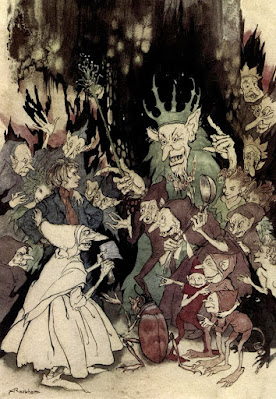 Trollkönig (Troll King)
Trollkönig (Troll King)





